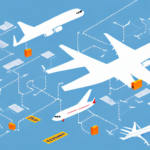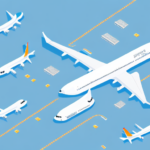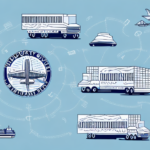Understanding the Basics of Air Waybill (AWB)
An Air Waybill (AWB) is a fundamental document that acts as a contract for the transportation of goods between a shipper and an airline. The AWB includes essential information about the shipment, such as the point of origin, destination, type and quantity of goods, and mode of payment. This article delves into the fundamentals of AWBs, their history, various types, the correct way to fill them out, and their significance in customs clearance and logistics planning.
What is an Air Waybill (AWB) and Why is it Important?
The Air Waybill (AWB) is a legal contract of carriage that confirms the receipt of goods from the shipper and obligates an airline to transport them to the specified destination. It is a critical document for both shippers and airlines as it facilitates the tracking of goods and ensures their safe delivery. The AWB includes details about the shipment, such as the type of goods, their value, dimensions, and weight.
One of the key benefits of an AWB is that it serves as proof of ownership of the transported goods. This is especially important for international shipments, where customs officials may require ownership proof before allowing goods to enter a country. Additionally, the AWB can be used as collateral for financing or insurance purposes.
Furthermore, the AWB ensures that goods are transported safely and securely by outlining packaging and handling requirements, as well as any special instructions or precautions needed during transit. This minimizes the risk of damage or loss, which can be costly for both the shipper and the airline.
For more detailed information, refer to the International Air Transport Association (IATA) guidelines on AWBs.
The History of Air Waybill (AWBs)
AWBs have been a staple in the international airfreight industry since the 1920s. Initially, they were paper-based documents that had to be physically transported alongside the goods. The advent of computerized systems in the 1970s led to the development of electronic AWBs, streamlining the process and reducing paperwork.
With the growth of e-commerce and global trade, the importance of AWBs has surged. The International Air Transport Association (IATA) introduced the standard format for electronic AWBs, known as e-AWB, which has been widely adopted by airlines and freight forwarders. This advancement has resulted in faster processing of air cargo shipments, enhanced tracking, and better visibility for customers.
However, challenges remain, particularly concerning the lack of standardization across different countries and regions. This inconsistency can cause confusion and delays in shipment processing, increasing costs for businesses. Initiatives like the Multilateral Electronic Air Waybill Agreement aim to establish a global standard for electronic AWBs, addressing these issues.
The Different Types of Air Waybills (AWBs)
There are several types of AWBs, each serving specific purposes:
- Master Air Waybill (MAWB): Issued by the carrier, covering the entire shipment from origin to final destination.
- House Air Waybill (HAWB): Issued by a freight forwarder or consolidator, covering specific parts of the shipment, often used for consolidating goods from different shippers.
- Through Air Waybill (TAWB): Utilized when a shipment involves multiple carriers, with each carrier issuing its own AWB for its segment of the journey.
- Electronic Air Waybill (e-AWB): A paperless version transmitted electronically between parties, enhancing efficiency and reducing errors.
Each AWB type serves as a contract of carriage between the shipper and the carrier, containing vital information such as the names and addresses of the shipper and consignee, a description of the goods, shipment weight and volume, and the terms and conditions of carriage. Accuracy and completeness of this information are crucial to prevent delays or issues during shipment.
How to Fill Out an Air Waybill (AWB)
Completing an AWB accurately is essential to ensure smooth transportation of goods. Here are the key steps:
- Shipper and Consignee Information: Provide accurate names, addresses, and contact details for both the shipper and the consignee.
- Description of Goods: Detail the type of goods, including quantity, weight, dimensions, and any special handling requirements.
- Terms of Shipping: Specify the mode of payment and any specific terms agreed upon.
- Dangerous Goods: Clearly mark and provide necessary documentation if the shipment contains hazardous materials.
- Consistency Across Documents: Ensure that the information on the AWB matches other shipping documents like the commercial invoice and packing list to avoid customs clearance issues.
Using the latest AWB forms and double-checking all entries can prevent delays, additional charges, or rejections by the airline.
Common Mistakes to Avoid When Filling out an Air Waybill (AWB)
Errors in filling out an AWB can lead to significant issues. Common mistakes include:
- Providing incorrect or incomplete information.
- Using outdated forms.
- Writing with pen instead of black or blue ink, which can blur or fade over time.
- Failing to label dangerous goods appropriately.
- Inaccurate weight and dimension measurements, leading to delays and additional charges.
- Not adhering to airline-specific guidelines and regulations.
To avoid these mistakes, always use the latest AWB version, verify all details, and follow the airline’s instructions meticulously. Additionally, understanding and complying with shipping regulations for specific items, such as hazardous materials or perishable goods, is crucial to prevent fines, delays, or legal repercussions.
The Role of the Airline in Handling the Air Waybill (AWB)
Once the AWB is filled out and submitted, the airline takes on the responsibility of transporting the goods to the destination specified. The airline verifies the shipment details, provides a tracking number, and confirms the shipment’s acceptance. Their responsibility ends when the goods are delivered to the consignee or their authorized representative and properly signed for.
The airline uses the AWB to manage the shipment efficiently, ensuring it follows the correct routing and handling procedures. This process is integral to maintaining the reliability and reputation of the airline in the logistics chain.
How an Air Waybill (AWB) Helps with Customs Clearance
The AWB is crucial for customs clearance as it provides customs officials with essential information about the shipment and its contents. By examining the AWB, customs can:
- Identify the type and quantity of goods.
- Assess tariffs, taxes, and other fees related to the shipment.
- Verify compliance with import and export regulations.
Accurate information on the AWB facilitates a smoother customs clearance process, reducing the risk of delays or misclassification of goods.
Tracking and Tracing Your Shipment Using an Air Waybill (AWB)
The AWB contains a unique serial number that enables the tracking and tracing of shipments from origin to destination. Both shippers and consignees can use this number to:
- Monitor the shipment’s real-time status.
- Receive updates on the shipment’s location.
- Estimate the delivery time.
Effective tracking ensures transparency and provides peace of mind, allowing stakeholders to manage their logistics more efficiently.
What to Do If There's a Problem with Your Air Waybill (AWB)
If issues arise with your AWB, such as missing documents, inaccurate information, damaged goods, or delays, it is imperative to take immediate action:
- Contact the Airline or Freight Forwarder: Reach out promptly to address and rectify the problem.
- Provide Necessary Documentation: Supply any additional documents or corrections required to resolve the issue.
- Monitor Shipment Status: Keep track of the shipment to ensure that the problem is being handled effectively.
Timely reporting and resolution can prevent further delays and ensure the goods reach their destination as planned.
The Future of Air Waybills (AWBs) and Electronic Documentation
The future of AWBs is moving towards full electronic documentation. While paper-based AWBs are still used in many regions, electronic AWBs (e-AWBs) are rapidly becoming the standard due to their numerous advantages:
- Efficiency: Electronic documentation speeds up processing and reduces administrative burdens.
- Accuracy: Digital entries minimize errors associated with manual data entry.
- Environmental Impact: Reducing paper usage contributes to environmental sustainability.
- Enhanced Tracking: Real-time updates and better visibility throughout the shipping process.
The adoption of e-AWBs is supported by industry standards set by organizations like IATA, promoting a more integrated and efficient global air freight system.
Understanding the Differences Between AWBs and Bills of Lading
While both AWBs and Bills of Lading are used in the transportation of goods, they cater to different modes of transport:
- AWB: Used for air shipments, issued by airlines, and governed by the IATA regulations.
- Bill of Lading: Used for sea or land shipments, issued by carriers, and governed by international maritime conventions like the Rotterdam Rules.
Both documents contain similar information but differ in their handling, legal frameworks, and applicability based on the transportation mode.
How AWBs Affect International Trade and Transportation
AWBs play a pivotal role in international trade and transportation by providing the legal basis for the air transportation of goods. They facilitate:
- Efficient Movement: Streamlining the shipping process across international borders.
- Legal Compliance: Ensuring that shipments adhere to international laws and regulations.
- Risk Management: Providing clear terms and conditions that protect both shippers and carriers.
- Economic Growth: Enabling businesses to expand globally by ensuring reliable and timely delivery of goods.
The structured information within AWBs helps in maintaining transparency, reducing disputes, and fostering trust among international trading partners.
The Importance of Accurate AWB Information for Logistics Planning
Accurate information on the AWB is critical for effective logistics planning. It allows shippers and consignees to:
- Plan for the timely receipt and distribution of goods.
- Allocate resources and personnel appropriately upon delivery.
- Anticipate and mitigate potential delays or issues in the supply chain.
Incomplete or incorrect AWB information can lead to:
- Delays in shipment processing and delivery.
- Increased costs due to additional handling or storage fees.
- Potential loss or misrouting of goods.
Therefore, meticulous attention to detail when filling out AWBs is essential for seamless logistics operations.
In Conclusion
Air Waybills (AWBs) are indispensable documents in the air transportation of goods. They establish the legal framework for shipping, provide critical shipment information, and ensure that goods are delivered safely and on schedule. Understanding the fundamentals of AWBs, including their history, types, and the importance of accuracy, empowers shippers and consignees to navigate the complexities of air logistics efficiently. As the industry continues to embrace electronic documentation, the role of AWBs in facilitating global trade will only become more integral and streamlined.




















